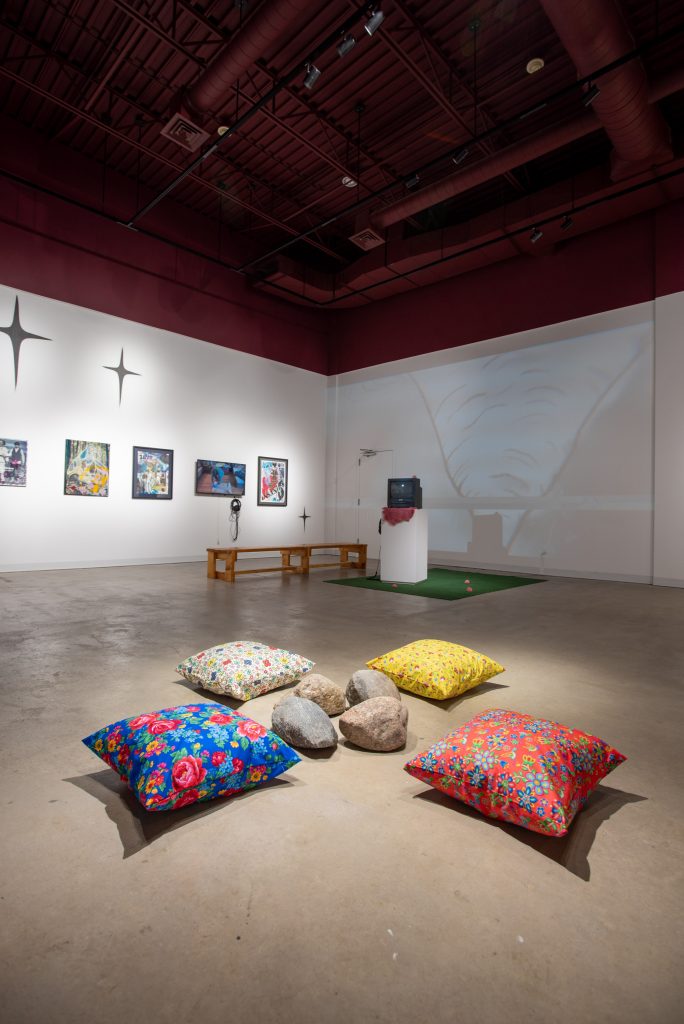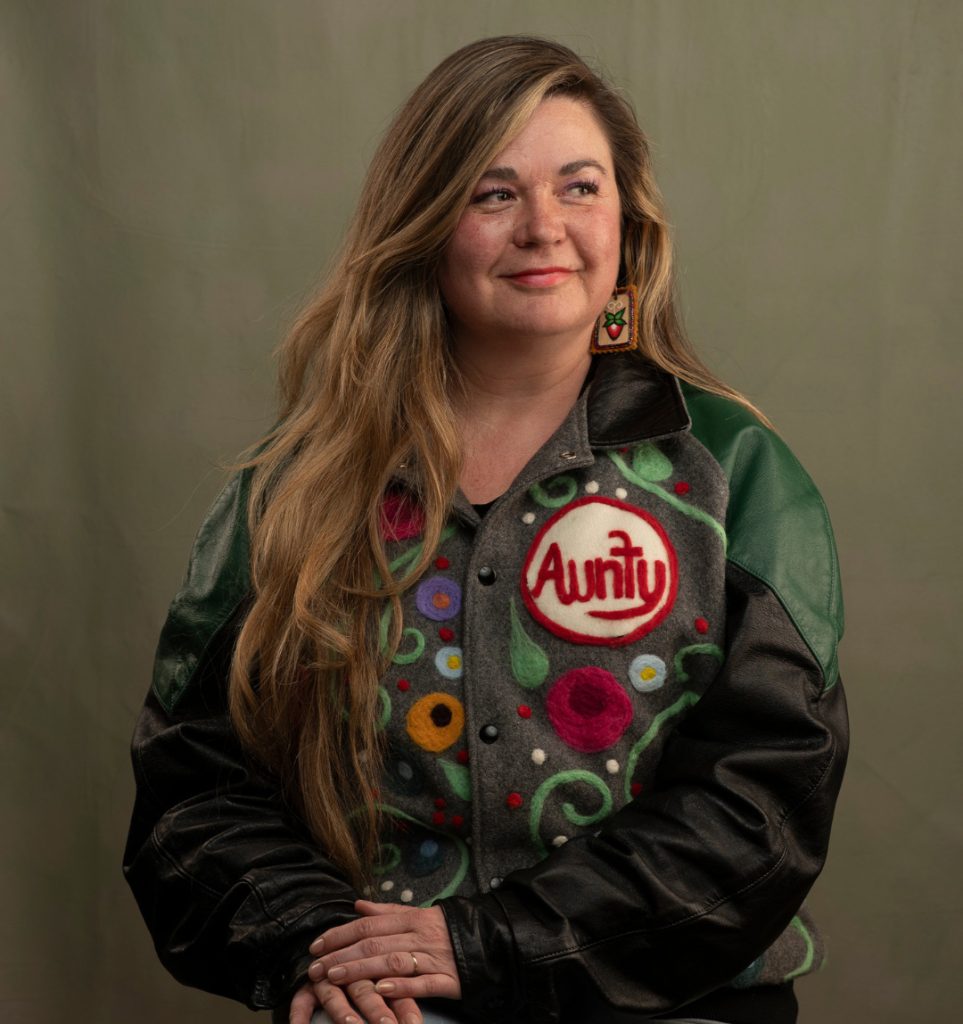
The Future is Ancestral
Oct 25, 2025 – Jan 24, 2026









Curated by Melanie Monique Rose
Advisor: Kokum Brenda Dubois
Indigenous folks tend to agree that time is not linear. Perhaps it looks like a wave hitting the shoreline, leaving and returning…? Does time look like a sunflower, a fiddlehead or a pinecone — or the curls in your hair? Spiralling, whorling and looping like the fingerprints on our hands? Storytelling is how we make sense and relate to time, to the present, past and future. The Future is Ancestral is a gathering of visual storytellers, storykeepers, portal builders and truth seekers. Some of these artists ask, “If we haven’t gone through truth yet, how can we have reconciliation?” They pull out stories and strings, undo and weave, unravel myths, false and pseudo histories. They relate to the past and consult the Elders to understand the present, to imagine futures. Like water in its nonlinear temporality, it is at once ancestral and present in the here and now. “Rivers, those beings that have always inhabited different worlds, are the ones that suggest to me that if there is a future to imagine, it is also ancestral, since it’s already present.” Ailton Krenak, Ancestral Future
The Future is Ancestral exhibition at the Godfrey Dean Art Gallery is curated by Melanie Monique Rose with the support of Advisor Kokum Brenda Dubois and Artistic Director Doreen Girard. The artists are Torrie Ironstar, Robyn Adams, Rhikee Strapp aka Miskwa the Mad Clown Prophet and the Time Travel Collective – Nyle Miigizi Johnston, Virginia Eichhorn and Joel Richardson.
Advisor: Kokum Brenda Dubois

Matriarch
Muscowpetung First Nation
Curator: Melanie Monique Rose

Melanie Monique Rose is a Metis/Ukrainian visual artist from Regina, Saskatchewan Treaty 4 Territory, a citizen of the Metis Nation of Saskatchewan, and a long-time contributing member ofSâkêwêwak Artists’ Collective Inc. and board member. Rose’s work centres on kinship and relationships between the land, ourselves and each other. Through plants and flowers Rose invites transmissions of ancestral knowledge and teachings while also imagining and creating a de-colonial future through the lens of Metis worldviews.
She attended Kootenay School of the Arts with a major in the Fibre Arts in Nelson, B.C. Rose has exhibited her artwork in both group and solo exhibitions. Most recently, Melanie has her largest showing of work to date in her solo show, Li moond di fleur at the Woodland Cultural Centre in Brantford Ontario. In the summer of 2023 Melanie’s natural dye practice took her to both Ottawa, at the National Gallery of Canada and Santa Fe, New Mexico’s SWAIA Fashion shows, where her work walked the runway. A recent career highlight was exhibiting in the group show, Storied Objects/Metis Art in Relation at the Remai Modern in Saskatoon, Saskatchewan. A great honor was to receive the distinction of Excellence in Textiles from the Saskatchewan Craft Council in Dimension’s 2013 touring show. In 2020, Melanie was named a CBC Future 40 for her work in arts and culture. In addition, she was one of seven artists awarded the Saskatchewan Foundation for the Arts Endowment Award to further artistic pursuits in 2021. In 2023 she was honored with the Queen Elizabeth II Platinum Jubilee Medal from His Honour the Honourable Russ Mirasty Lieutenant Governor of Saskatchewan for her work in Arts & Reconciliation. Most recently she was awarded the 2025 Indigenous Resurgence in Action category for the Regina YWCA Women of Distinction.
Rose has works in Saskatchewan as an independent curator, gallery facilitator, story-keeper, and art instructor and in addition teaches various workshops at both public and private institutions.
In 2018 her daughter Meadow Rose was born and is currently a full-time mom, caregiver, and artist. Becoming a mother has increased Rose’s desire to share the stories of her culture and family and has challenged the way she creates independently and as a shared experience with her daughter. Rose is inspired and excited to see where the journey takes her as an Artist.
ARTISTS
Robyn Adams / Torrie Ironstar / Rihkee Strapp aka Miskwa the Mad Clown Prophet / The Time Travel Collective – Joel Richardson, Nyle Johnston & Virginia Eichhorn
Robyn Adams

Robyn Adams, Photographed by Marco Leung
Robyn Adams is a Red River Métis and Ukrainian landscape designer, artist, and filmmaker based between Vancouver and Winnipeg. She is a citizen of the Manitoba Métis Federation with Michif family who took scrip in Rat River Settlement. She recently graduated from the University of British Columbia with a dual Masters in Architecture and Landscape Architecture. Robyn has exhibited across Turtle Island, including at imagineNATIVE Film Festival, the Canadian Centre for Architecture, Godfrey Dean Art Gallery, and PLATFORM Centre for Photographic + Digital Arts. Her work looks at relationship with the land, and water through the intricate weaving of Indigenous knowledge, ceremony, art and architecture. She seeks to create an architecture of poetic joy, alongside the matriarchs who have helped steward a sense of home for Indigenous communities through the dark times, to forge paths into brighter futures.
Torrie Ironstar

Torrie Ironstar (b. 1985), Carry the Kettle Nakoda First Nation, SK) is a contemporary Indigenous artist whose work bridges identity, resilience, and cultural tradition. Deaf and Two-Spirit, Ironstar embraces these identities as central to his creative vision, transforming lived experience into vibrant visual languages.
Working primarily in acrylics and mixed media, his practice also spans collage, plexiglass, screen printing, and set design. His bold use of colour, symmetry, and geometric patterning draws inspiration from beadwork, Nakoda design systems, and the symbolic storytelling of artists such as Bob Boyer, Alex Janvier, and Frida Kahlo. The resulting works reflect cycles of healing, transformation, and renewal while celebrating Indigenous knowledge systems and personal narrative.
Ironstar has exhibited widely across Saskatchewan and beyond, with works held in the permanent collection of the Saskatchewan Arts Board, the Saskatchewan Cancer Agency, Casino Regina, P3A Design, and Carry the Kettle’s Education Centre. He has also collaborated with Articulate Ink as a screen printer, creating community-driven projects and fundraisers, and contributed to theatre and Truth & Reconciliation projects as a set designer. His art continues to gain recognition in exhibitions, auctions, and community spaces across Canada.
Rooted in his Nakoda heritage and Deaf perspective, Torrie Ironstar’s art embodies resilience and creativity, offering powerful reflections on identity, spirit, and transformation.
Rihkee Strapp aka Miskwa the Mad Clown Prophet

Rihkee Strapp – ‘Ditch Metis’ – photo by Arjun Lal
Rihkee Strapp entered the world from a sea of blood, fully grown wearing a gold set of armour. They are an Ayakwew, Red River Metis multi-disciplinary artist raised in Northern Ontario by nohkum’s dial-up internet and its dark vistas. Rihkee is an alumni of the Studio [Y] systems leadership fellowship at the MaRS Discovery District. Their highly collaborative work re-appropriates pop-culture, myth and nostalgia, playing with concepts of time and technology often using humour and character to animate their ideas.
The Time Travel Collective – Joel Richardson, Nyle Johnston & Virginia Eichorn

THE TIME TRAVEL COLLECTIVE: Conversations
Virginia Eichhorn has worked in the visual arts field for over thirty years. A professor at Georgian College (Barrie Campus) teaching in the Design & Visual Arts Department and in Sports Recreation & Hospitality. She is a graduate of the Art History programme at Queen’s University and continued her studies in Art History and Museum Studies at the University of Toronto. With an emphasis on ecological, environmental, and non-traditional exhibition spaces, her work as an independent curator has seen her presenting exhibitions at numerous prestigious venues including the XII Biennale of Art at Villa Nova Cerveira in Portugal. She has worked extensively with artists from across Canada and abroad, including Carl Beam, Judy Chicago, Maria Hupfield, Vessna Perunovich, Jane Ash Poitras, Jack Sures, and Peter Von Tiesenhausen, developing exhibitions for high profile Canadian galleries and museums such as the Royal Ontario Museum. In addition to curating, she has written numerous catalogue essays and has contributed articles to prominent Canadian magazines including Artichoke, Canadian Art, Border Crossings, ESPACE Sculpture and international magazines such as Ceramics Monthly and for institutions including the National Gallery of Canada, the MacKenzie Art Gallery, and others. She also has developed an art practice that is focused on alternative narratives and voices, using traditional and non-traditional art and craft forms. Her first solo exhibition The Power of the Feminine took place at the Temiskaming Art Gallery in 2023.
NYLE “MIGIIZI” JOHNSTON Johnston’s spirit name is Wiishkoonseh Miigizi’enh means Whistling White Headed Eagle. He grew up in Chippewas of Nawash Unceded First Nation and apprenticed with Storytellers since his youth. Sources of his artistic inspiration include woodland painters, Story Tellers and the traditions of his indigenous culture. Johnston notes: “In a time of reconciliation, it is important for all people to know that we exist and have such a strong, beautiful legacy of stories and teachings from the Anishinaabe Nation that are grounded in my experience and identity.” A painter, mural artist, traditional storyteller, and traditional helper, Johnston uses his gift of storytelling to connect his peoples’ stories of love and healing with the broader world and offer support to a range of community organizations. His work has been exhibited across many of Canada’s most important institutions, from the AGO and ROM to the Evergreen Brickworks and the Chippewas of Nawash Cultural Centre. His artistic practice is focused on illustrating stories of the Anishinaabe Nation in a variety of media in order to raise awareness of their unique histories as they in turn inform his process. He was born and raised on his beautiful reserve, Neyaashiinigmiing, on the Saugeen Peninsula (Bruce Peninsula) and took a keen interest in painting and art at a very young age. Johnston has an established portfolio of work and is well recognized in Toronto. His original works are showcased at the Art Gallery of Ontario (AGO) in the Jennings Young gallery (J.S. McLean Centre for Indigenous & Canadian Art). Johnston’s Diiyah Muh’gaanag (Our First Family) is a collection of images of spiritual beings, plants and animals based on Anishinaabe teachings. Drawn in a pictographic style, they tell stories of botany, astrology and the interconnectedness of all living things. Johnston currently lives in Toronto, Ontario, and is a contributing member to the Indigenous & Canadian collection at the AGO
Joel Richardson is a multi-media artist whose work spans over twenty years. His extensive body of art includes large scale installation, performance, re-workings of digital technology, video projections, film, portrait and mural painting. He rose to national attention in 2011 when then Toronto mayor Rob Ford erased his 150 meter long mural of a series of suitmen and women in business attire interspersed with the extensive Black-Scholes equation. This work was commissioned by the city of Toronto. The significance of this work with the eeriness of the Black-Scholes equation and its shady application to legally manipulate the stock markets, translated into further shows in New York, Miami, Moscow and Toronto. His recent major projects include a large-scale multi-faceted historical exhibition in collaboration with the Tom Thomson Gallery. He is currently working with Olympic champion Matthew Birrir on the “Metipso Portal”, an international community interactive collaboration with many participants and moving parts. Richardson states: “I am interested in how false representation can shape truth; what is sacred and what is profane and how they intersect and are intertwined. This often complex relationship between the sacred and the untrue – is at the core of my art practice.”
